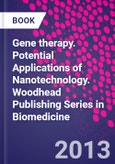Gene therapy is emerging as a new class of therapeutics for the treatment of inherited and acquired diseases. However, poor cellular uptake and instability of DNA in the physiological milieu limits its therapeutic potential, hence a vector which can protect and efficiently transport DNA to the target cells must be developed. Nanotechnology-based non-viral vectors have been proposed as potential candidates. Various polymeric nanoparticles have been shown to be suitable, with high cellular uptake efficiencies and reduced cytotoxicity. These delivery vectors form condensed complexes with DNA which result in shielding against enzymatic degradation and enhanced cellular targeting. Advantages including easy manipulatibility, high stability, low cost and high payload, mean that nanoparticles from various polymers have been exploited. Gene therapy gives a systematic account of the many aspects of nanotechnology mediated gene therapy, from the preparation of nanoparticles to physicochemical characterization, and follows with applications in in vitro and in vivo models. This book emphasizes the various aspects of nanotechnology-based gene therapy, with initial chapters detailing the tools and techniques available for preparation and in vitro and in vivo characterization of nanoparticles. Later chapters provide exhaustive details on polymeric systems employed for gene therapy.
Please Note: This is an On Demand product, delivery may take up to 11 working days after payment has been received.
Table of Contents
Dedication
List of figures and tables
Acknowledgments
Foreword
Preface
About the author
Chapter 1: Nanotechnology: an introduction
Abstract:
1.1 Introduction
1.2 Definition of nanotechnology
1.3 Structure of the book
Chapter 2: Methods of nanoparticle preparation
Abstract:
2.1 Introduction
2.2 Preparation of nanoparticles by polymerization of monomers
2.3 Preparation of nanoparticles using preformed polymers
2.4 Methods of controlled release
Chapter 3: Tools and techniques for physico-chemical characterization of nanoparticles
Abstract:
3.1 Introduction
3.2 Physico-chemical characterization
Chapter 4: Characterization of nanoparticles: in vitro and in vivo
Abstract:
4.1 Introduction
4.2 In vitro characterization of nanoparticles
4.3 In vivo characterization
4.4 Conclusions
Chapter 5: Theory and limitations to gene therapy
Abstract:
5.1 Introduction
5.2 Mechanism of gene delivery
5.3 Barriers to gene delivery
5.4 Conclusions
Chapter 6: Targeted gene delivery mediated by nanoparticles
Abstract:
6.1 Introduction
6.2 Approaches for targeted gene delivery
6.3 Conclusions
Chapter 7: Polymeric nanoparticles for gene delivery
Abstract:
7.1 Introduction
7.2 Advantages of nanoparticles
7.3 Limitations of nanoparticles
7.4 Conclusions
Chapter 8: Poly-L-lysine nanoparticles
Abstract:
8.1 Introduction
8.2 In vitro and in vivo applications of poly-L-lysine/DNA nanoparticles
8.3 Polylysine-containing peptides for gene delivery
8.4 Conclusions
Chapter 9: Chitosan nanoparticles
Abstract:
9.1 Introduction
9.2 Factors affecting transfection efficiency of chitosan nanoparticles
9.3 Conclusions
Chapter 10: Polyethylenimine nanoparticles
Abstract:
10.1 Introduction
10.2 Derivatives of PEI for in vitro and in vivo gene delivery
10.3 Degradable PEI for gene delivery
10.4 Conclusions
Chapter 11: Atelocollagen
Abstract:
11.1 Introduction
11.2 Atelocollagen-mediated gene delivery
11.3 Conclusions
Chapter 12: Protamine nanoparticles
Abstract:
12.1 Introduction
12.2 Protamine nanoparticles for gene delivery
12.3 Liposome/protamine/ DNA complexes
12.4 Protamine conjugation to other ligands
12.5 Conclusions
Chapter 13: Dendrimers
Abstract:
13.1 Introduction
13.2 Dendrimers in gene delivery
13.3 Conclusions
Chapter 14: Cyclodextrins and cyclodextrin-containing polymers
Abstract:
14.1 Introduction
14.2 Cyclodextrin-embedded polymers
14.3 Polymers with cyclodextrins as pendant groups
14.4 Cyclodextrins as adjuvants for enhanced gene delivery
14.5 Cyclodextrin-based polyrotaxanes
14.6 Conclusions
Chapter 15: Poly(D,L-lactide-co-glycolide)-based nanoparticles
Abstract:
15.1 Introduction
15.2 PLGA nanoparticles for gene delivery
15.3 Chitosan-modified PLGA nanoparticles
15.4 Polyethylenimine-modified PLGA nanoparticles
15.5 Other modifications to PLGA nanoparticles
15.6 Conclusions
Chapter 16: Metallic and inorganic nanoparticles
Abstract:
16.1 Introduction
16.2 Gold nanoparticles
16.3 Mesoporous silica nanoparticles
16.4 MSN for gene delivery
16.5 Polycation-modified MSN for gene delivery
16.6 Conclusions
Index








